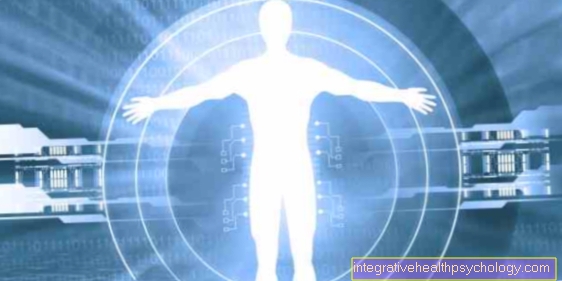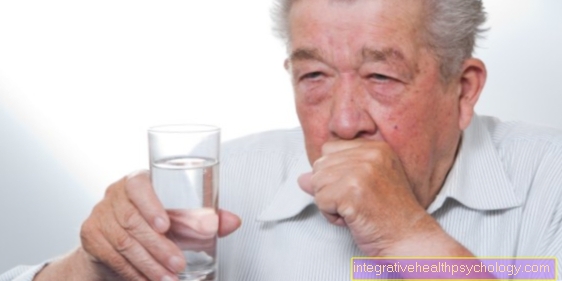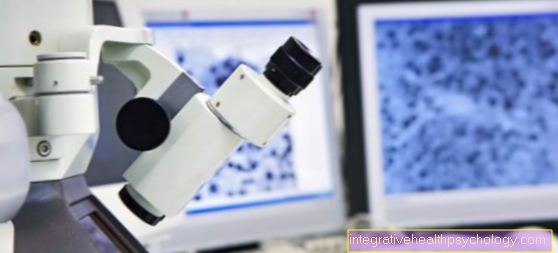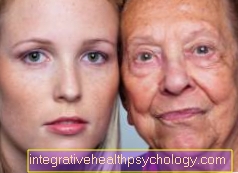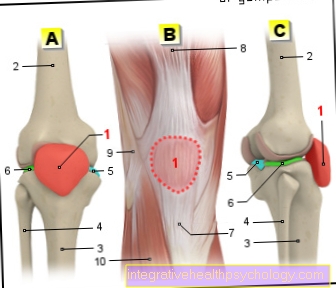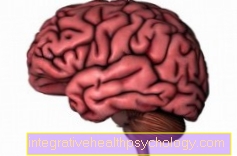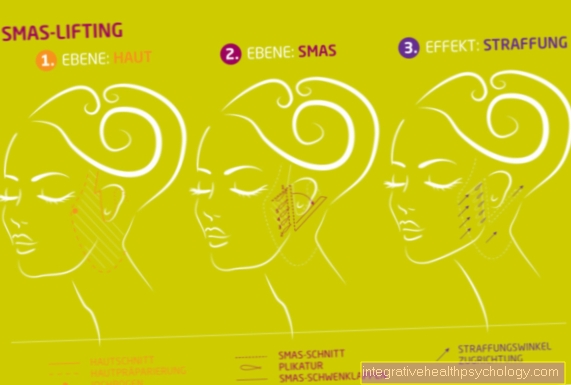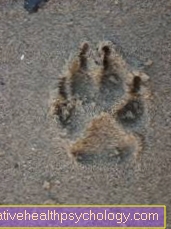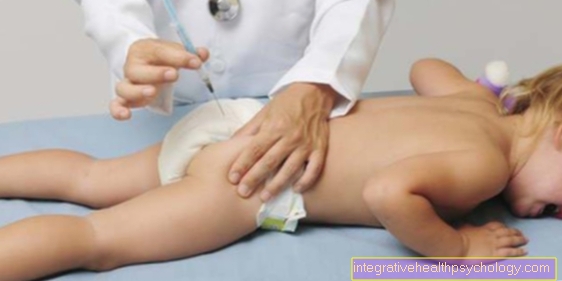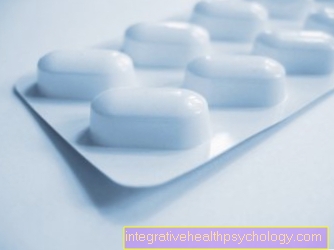Symptoms of a heart attack
introduction
A Heart attack usually comes as a surprise and can hide behind a variety of symptoms. The Leading symptom in a heart attack is the typical chest pain behind the sternumthat of a burning sensation is accompanied.

What can be the signs of an impending heart attack?
Patients who suffer a heart attack usually have a CHD - a coronary artery disease. This disease of the heart vessels starts with a narrowing of the diameter by fatty wall thickenings (Stenoses) hand in hand. The main symptom of CHD and thus the first sign of a potentially impending heart attack is the Angina pectoris (German: Brustenge).
This leads to pain behind the breastbone, which can spread to different parts of the body, e.g. can radiate the left arm, the lower jaw or the back. Often the pain occurs suddenly and at rest. In addition, so-called vegetative symptoms often occur. These “body symptoms” manifest themselves in the form of sweating, nausea and vomiting. Since angina pectoris is a very frightening symptom for most patients, the majority of those affected suffer from anxiety and restlessness. Blood pressure often drops, but it can also be normal or elevated.
Basically, the symptoms that occur are more severe and serious the larger the heart attack. Even at rest, the symptoms of an acute heart attack typically do not improve, and targeted breathing movements do not bring any relief.
The duration of a classic angina pectoris episode is about 10 minutes. If the symptoms last longer or if they cannot be broken by administering nitroglycerin (a vasodilator drug), the disease may already be more acute, which requires immediate clarification.
The triggering factors are physical as well as emotional stress, very low outside temperatures (lead to additional vasoconstriction) or increased pressure in the abdominal cavity (when the digestive tract is distended, so-called "Roemheld syndrome").
But not everyone feels the symptoms that are triggered by a heart attack in the same way. There are differences between the symptoms that typically occur in women and men.
Some heart attacks (around 15 to 20 percent of all heart attacks) cause no, only minor or atypical symptoms (so-called "silent heart attack").
These silent heart attacks occur more frequently in people with diabetes, since diabetes mellitus disease leads to autonomic neuropathy (Damage to the pain-conducting nerves of the organs) comes.
As a result, diabetics may not be able to perceive the heart attack pain and suffer a symptom-free (silent) heart attack. These heart attacks are often only detected later, usually during an electrocardiogram examination (EKG).
Symptoms very similar to those of a heart attack can also be triggered by other life-threatening diseases in the chest area. For example, a tear in the large body artery (aortic dissection), a pneumothorax (air in the pleural space with collapse of the lungs) or a gastrointestinal tract disease can lead to heart attack-like symptoms.
Read more about this under: Signs of a heart attack
Symptoms of a heart attack
Symptoms in women and men
In women, a heart attack is often announced with different alarm signals than in men. Knowing these gender differences in the symptoms of a heart attack is very important so that no mistakes are made in an emergency and the heart attack may be detected too late.
The slightest indication of a heart attack must be taken seriously, regardless of the type of complaint, as sudden cardiac arrest can occur at any time without further notice.
The classic distinguishing marks (such as chest pain, which can radiate into different parts of the body) occur in both sexes. However, only about a third of women experience the severe chest pain, while up to 80 percent of men experience this first symptom of heart attack.
However, it is not uncommon for a heart attack to trigger rather unspecific symptoms in women. These include, for example, severe shortness of breath, nausea, vomiting and, in particular, discomfort in the upper abdomen. If these symptoms are particularly severe or last longer than 15 minutes, it is important to think about a heart attack.
About half of women who have a heart attack experience sleep disorders before an acute heart attack.
Men often perceive the symptoms in the chest area as the greatest pain (with or without radiation). In a woman it often happens that instead of severe pain, a feeling of pressure or tightness is perceived.
Symptoms such as recurring nausea, tiredness or dizziness can appear days before the heart attack and are often misinterpreted as stomach problems.
The so-called NAN rule can help in recognizing heart attack symptoms in women: If inexplicable pain occurs in the body area between the nose, arm and navel that lasts longer than 15 minutes, an emergency doctor should be called in any case, as this is a sign for you Heart attack.
Read more about the topic here: Tension in the chest
Chest tightness
Chest tightness is one of the most prominent symptoms of an acute heart attack. In technical jargon, it is called angina pectoris (= oppression / constriction of the chest). Patients describe this condition as having a heavy burden on their chests that they cannot breathe properly against.
The cause is not to be found in the lungs, but in the occlusion of a coronary artery, as is the case with a heart attack. The tightness can usually be treated with nitrospray. The nitrogen contained in it ensures that the blood vessels are widened in the body and the blood can flow through the coronary vessels again.
For more information, see: Angina pectoris
Heart attack blood pressure
One of the most important measures to prevent cardiovascular disease is taking regular blood pressure measurements. If during a check-up the values are clearly higher than usual, or if the values increase slowly over a longer period of time, this can indicate a heart attack.
It is important that the blood pressure measurement takes place at rest and is initially repeated again if the values are abnormal. If symptoms that are typical of a heart attack, such as chest pain, shortness of breath or blurred vision, occur at the same time as the increase in blood pressure, these symptoms can be a warning sign of a heart attack.
More precisely, high blood pressure is a risk factor for CHD (coronary artery disease). CHD, in turn, increases the risk of suffering a heart attack because the coronary arteries are narrowed. High blood pressure alone is not a symptom of a heart attack.
Often times, it is more likely that blood pressure will drop and the heart rate will slow down (Bradycardia). Due to the damage to the heart muscle cells, the pumping capacity decreases, which means that not enough blood can be transported into the circulation. It is important to adjust the blood pressure as well as possible for both high-risk patients and those who have had a heart attack. Two of the high blood pressure drugs (ACE inhibitors, beta blockers) have a positive effect on the heart after a heart attack, which is why a corresponding prescription is very useful.
An acute symptom of a heart attack are often cold sweats, and the person affected has cold and clammy hands.
These are signs that the circulation has collapsed, and it is not uncommon for unconsciousness to occur. The onset of cardiovascular failure is indicated by a rapid pulse rate (heart rate over 100 per minute) and low blood pressure (the upper value is below 90mmHg).
The blood pressure (and also the pulse rate) can react very differently to a heart attack. In some cases the heart starts racing, in others it slows the pulse rate sharply, and blood pressure can rise as well as fall.
Symptoms on the arm
The localization of symptoms in a heart attack often depends on which coronary vessel is affected. If the right coronary artery is affected, what is known as a posterior wall infarction usually results, which is more likely to be expressed by discomfort in the upper abdomen.
An obstruction in the left coronary artery usually leads to anterior wall infarction, in which the pain is more likely to be felt in the chest area.
The most common form of pain radiation is that in the left arm. The pain moves from the chest over the shoulder into the upper arm and spreads to the forearm or even to the hand (especially on the side of the little finger). Such a course cannot be observed in all patients. Women in particular often do not show the typical clinical picture with chest pain and accompanying charisma.
More information can be found here: Pain in the left arm as a sign of a heart attack
In the event of sudden arm pain and a corresponding risk profile (smoking, diabetes, high blood pressure, etc.), an ECG should be taken as soon as possible to check the symptoms. In the differential diagnosis (possible other diagnosis), if there is pain in the left arm, damage to the nerves, a disruption of the muscles and tendons or the joint structures must also be considered.
Heart attack patients rarely experience pain in their right arm.
It also happens that the pain radiates into both arms. In addition, there may be pain in the shoulders (more on the left side) that are independent of movement.
Sometimes no chest pain is perceived and there is only permanent and unwilling pain in the left arm, which the person concerned cannot explain. This phenomenon can also occur during an acute heart attack and is often misdiagnosed as rheumatic pain. Arm pain can be a symptom of many conditions, such as bottleneck syndrome, in which the upper bone of the scapula sags and puts pressure on the lower bone.
This leads to a constriction of the vessels and nerves located there, causing pain that radiates into the arm.
Burning sensation during a heart attack
A burning sensation is usually an expression of the pain that those affected experience during the heart attack. The pain usually spreads to the left arm or the left shoulder. Other places where the pain or burning sensation can radiate are the back, neck or, in rare cases, the abdomen.
Anxiety sweat during a heart attack
Sweat is a completely natural reaction to a heart attack. In most cases, heart attacks are accompanied by fear of death. In this context, the sweat of fear is the reaction to the enormous adrenaline rush of the body.
The person concerned does not necessarily know that he is currently suffering from a heart attack; but has the feeling of dying from the attack he is currently going through. In the acute event, this affects about a third of all people. Another twenty percent will die in the coming days and weeks.
Heartburn during a heart attack
It is well known that heartburn causes gastric juice to flow back into the esophagus. It comes - often after a particularly rich supply of food - to an unpleasant burning sensation, which can rise up to the throat, and "acid belching". The gastric juice irritates the esophagus enormously, which can become inflamed as a result (Reflux esophagitis). Heartburn, especially when combined with such inflammation, can cause tremendous pain down the course of the esophagus. Due to their anatomical location, the pain behind the breastbone is then present, which is why heartburn (or reflux esophagitis) is an important differential diagnosis (possible other diagnosis) of acute myocardial infarction. In particular, patients who are experiencing reflux for the first time can be unsettled by the pain they experience, although there is no need to worry.
Read more on the topic:
- Heartburn medication
- Diet for heartburn
Nausea, vomiting and diarrhea during a heart attack
In the case of a heart attack, vegetative symptoms (unconscious, uncontrollable, so-called body symptoms) can also occur. At the heart there are fibers of the autonomic nervous system - from Sympathetic and from Parasympathetic nervous system. They can be activated by the disturbed function - during the heart attack - and the rising panic. In addition to sweating (sympathetic nerve), nausea and vomiting (parasympathetic nervous system) are also classically part of the clinical picture. Nausea and vomiting often occur even with silent heart attacks when the main symptoms, such as chest pain, remain hidden.
Concomitant diarrhea is somewhat rarer, but it is also caused by the parasympathetic nervous system and its motility-increasing Effect (increase in bowel movement) can be triggered. The diarrhea is usually not as severe as with a bacterial or viral intestinal infection. Especially in connection with silent or untypical heart attacks cardiovascular (concerning the cardiovascular) events of diarrhea have been reported, which can lead to confusion and misdiagnosis during diagnosis.
Read more on the topic: Anti-vomiting medication
Numbness and tingling sensation during a heart attack
Symptoms such as numbness or tingling are usually due to stress or damage to nerve structures, but can also occur as part of a heart attack. Many sufferers report that the sensory disturbances slowly spread in one region of the body, similar to the feeling when e.g. the arm “falls asleep”.
It seems to be particularly common to experience tingling sensations in the face and left arm. The numbness can reach into the fingers. The sensations are mainly due to the decreased blood flow. In many cases, the heart attack leads to massive circulatory problems, a drop in blood pressure and cardiac arrhythmias, from which the corresponding symptoms result.
Symptoms of a silent heart attack
A silent heart attack is not accompanied by the classic symptoms that normally characterize the disease. Mute heart attacks are particularly common in long-term diabetics. These are mostly chronic Polyneuropathy, a steadily progressing loss of nerve. As a result of this loss, the patients feel less pain and can no longer perceive stimuli from the vegetative (involuntary, physical) nervous system. The main symptom of chest pain is then absent and diagnosis is extremely difficult.
In the case of a silent heart attack, other symptoms are often in the foreground - such as nausea, vomiting or dizziness - which mislead the treating physician, but also the patient. A heart attack can be mistaken for a simple infection, which can have fatal consequences under certain circumstances. In addition to diabetics, women, the elderly in general, patients with heart surgery or kidney disease are at increased risk of suffering a silent heart attack with few or no symptoms. An ECG should therefore be written regularly, even if the symptoms do not directly suggest a heart attack.
For more information on this topic, read also: The silent heart attack
How are the symptoms in young people?
Basically, a heart attack is a disease of middle and old age. From the age of 45, the risk increases steadily until it reaches its peak at around 60 years of age. However, young people can also have a heart attack. Usually this does not happen without further ado, but through genetic risk factors, heart defects that have existed since birth or massive malnutrition with accompanying obesity at a young age.
Read more on the topic: Diet for heart disease
The symptoms in young patients are no different from those in older ones. In young people, the chance of a quick diagnosis is greater, on the one hand, because the nervous system detects changes and pain stimuli even more sensitively - not as in older patients. On the other hand, the diagnosis of myocardial infarction is atypical for patients of a lower age group, which in turn can delay the diagnosis. An EKG can be done quickly and inexpensively and should therefore not be left out in young people either.
The following topic may also be of interest to you: How can you prevent a heart attack?
Atypical symptoms of a heart attack
Atypical symptoms can massively hinder the diagnosis of a heart attack. As a rule, they occur in addition to the main symptoms, but they can also determine the clinical picture entirely, which makes it difficult for the treating physicians to correctly assess the situation. Atypical symptoms mostly relate to other parts of the body that are not directly related to the heart.
Examples of this are complaints in the gastrointestinal tract (nausea, vomiting and diarrhea), increasing shortness of breath or pain in the abdomen.
The symptoms come about in different ways. On the one hand, fibers of the vegetative (involuntary, physical) nervous system (sympathetic, parasympathetic) can be irritated by the infarct, which can trigger dysregulation (such as vomiting and diarrhea) in various organ systems. On the other hand, the anatomical proximity to other structures and the impairment of the heart function play a role. Upper abdominal pain arises, for example, from the pain projection (transmission, transmission) from the heart.
Shortness of breath
The shortness of breath is one of the atypical signs of a heart attack. While in men it is almost always the combination of angina pectoris and referred pain, women in particular are more often affected by atypical symptoms such as shortness of breath.
Furthermore, pain in the gastrointestinal area is one of these atypical symptoms.A morphine drug is given to patients to treat breathlessness or the feeling of suffocation. This has a calming effect and thus suppresses shortness of breath.
Our next article might be helpful to you: Difficulty breathing due to a weak heart
Back pain
Back pain is one of the most common accompanying pain associated with a heart attack. They are usually piercing in character, very intense, set in suddenly and are localized in the upper half (thoracic spine area). The pain is a so-called transference. Due to the anatomical proximity of the heart, the pain caused there is projected into other regions by also stimulating the corresponding pain fibers.
A very important differential diagnosis (other diagnosis with similar symptoms) is an aortic dissection. The wall layers of the main artery (aorta) become detached from one another or, in the worst case, tear. The result can be massive, life-threatening bleeding, which is why this should always be considered if the back pain suddenly sets in.
Read more on the topic: Upper back pain, burning sensation in the back
Shoulder pain
The main symptom of a heart attack is sudden, very severe pain. These are most commonly located in the chest and / or left arm. Shoulder pain is the third most common. These also exist on the left side of the body and are similar in their painful nature to the other localizations.
Other causes of sudden onset of shoulder pain on the left side are damage to the muscle, tendon and bone structures or to nerve fibers, some of which run in thick bundles (e.g. brachial plexus) in anatomical proximity. In addition, movement restrictions or movement-dependent pain usually occur, which would be atypical side effects of a heart attack.
Racing heart
During a heart attack, palpitations are mainly triggered by the dwindling pumping capacity and falling blood pressure. What is known as a heart attack often occurs during a heart attack cardiogenic shock (from the heart). The blood pressure drops extremely and the heart tries to create a balance by accelerating the frequency in order to guarantee the supply of the body.
In addition to the symptoms of shock, palpitations are also an early complication of heart attacks. As a cardiac arrhythmia are ventricular tachycardias (Tachycardia) found in 10-30% of cases. This can turn into ventricular fibrillation, which is a life-threatening condition that should be treated with electrical defibrillation.
The complications are the reason why infarct patients have to be observed in hospital for a while before they - treated and medicated (if the patient so wishes) - are released into the home environment.
Read more about the topics:
- Increased pulse - when is a pulse considered too high?
- Therapy of heart stumbling
- Therapy of cardiac arrhythmias
Panic attack
In addition to the pain and the physical symptoms, a heart attack also represents an enormous psychological burden. Many patients notice the changes at the moment of the infarction: chest tightness, sharp pain, sweating, stumbling of the heart (Palpitations), shortness of breath. All of these side effects produce, understandably, massive states of anxiety in many patients, some of which can even increase to fear of death. A panic attack subconsciously increases the symptoms, as it is also characterized by similar symptoms.
Such an experience can lead to trauma, which can lead to problems even after recovery and professional medical care. Even the smallest changes in the body lead to panic attacks, which can be counteracted with psychotherapeutic help.
Read more about the topics:
- Rehabilitation after a heart attack
- Psychosomatic palpitations
- Mentally induced shortness of breath
Duration of symptoms of a heart attack
In most cases, a heart attack is preceded by the first signs, but these are not perceived as such. Heralds of a heart attack are, for example, non-specific abdominal pain, nausea or dizziness.
These symptoms can occur many weeks before the actual heart attack, but are often misjudged. It is typical of the heart attack that the symptoms and especially the pain symptoms last longer than a normal angina pectoris attack.
Angina pectoris refers to an uncomfortable feeling in the chest, a constricting and pressing chest pain or even a "pain of destruction". Particularly during physical exertion, the tightness in the chest is an alarm signal from the body that the blood supply to the coronary arteries is disturbed.
An angina attack typically lasts anywhere from a few seconds to a few minutes. If the seizures occur more frequently, become more intense or if the chest pain lasts longer (15 to over 30 minutes), this is suspect for a heart attack.
Basically: As soon as severe pain in the chest lasts longer than five minutes, you should call the emergency doctor immediately. In case of doubt, a heart attack should always be ruled out, but under no circumstances should you transport the person to hospital or let the person drive independently.
Prognosis of a heart attack
It is important to take symptoms that indicate a heart attack seriously and to have them checked out by a doctor. The time between the onset of the acute infarction and medical care, i.e. until the affected coronary artery reopens, plays an important role in the course and prognosis after a heart attack.
The survival of a heart attack is significantly influenced by two serious complications: the occurrence of cardiac arrhythmias (especially ventricular fibrillation) and the occurrence of pump failure or cardiogenic shock. After a heart attack, it is rather unfavorable for the long-term prognosis if a heart failure develops.
Long-term physical resilience after a heart attack also depends on the extent of damage to the heart muscle and the future development of coronary artery disease.
In addition, it is crucial how successfully the risk factors for another heart attack (e.g. high blood pressure, high blood lipid levels, diabetes mellitus) are treated and how consistently a healthy lifestyle is adhered to (e.g. no smoking, being overweight, exercise, reducing stress). This is the only way to achieve normal life expectancy and age-appropriate performance.
Within the first two years after an acute heart attack, around 5 to 10 percent of those affected die from sudden cardiac death. The risk increases with age; the death rate among those over 75 is more than three times as high. After a year, around 80 percent of those who survive the first day after a heart attack are still alive.
Read our next topic under: How can you prevent a heart attack?
How do the symptoms of a heart attack differ from those of a stroke?
A heart attack and a stroke are only alike in one aspect: both clinical pictures arise from an occlusion of a supplying vessel, whereby the stroke can also be caused by local bleeding. Otherwise, apart from their often drastic effects on the patient's life, the clinical pictures have little in common. A heart attack closes one or more coronary arteries, is characterized primarily by chest pain and shortness of breath, and is often accompanied by vegetative (involuntary, physical) and psychological symptoms. In the case of atypical heart attacks, the pain symptoms may be completely absent and the vegetative part (body symptoms such as nausea, vomiting) are in the foreground.
The stroke is caused by a blockage or bleeding in a blood vessel that supplies the brain. The symptoms can be extremely complex and depend largely on the location of the event. From movement disorders to sensory disorders, speech and vision disorders, the clinical picture can also show itself in vegetative problems or psychological abnormalities.
Read more on the topic: Stroke - What Are The Signs ?, Stroke Therapy
In the case of both diseases, if the respective symptoms have been correctly identified, action must be taken immediately. Do not hesitate to consult the emergency services so that the fastest possible care can be guaranteed. In both clinical pictures, one tries to reopen the closed vessels in the shortest possible time in order to keep the cell damage in the supply area as low as possible.
Read more on the topic: resuscitation








